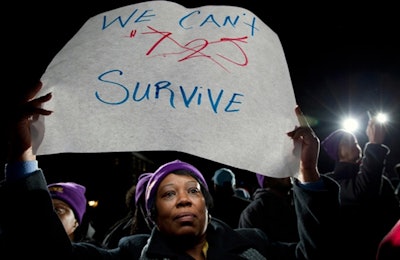
Although 2015 has just begun, it has already been a big year for advocates for a higher minimum wage. On Thursday, January 1, President Obama’s executive order to raise the minimum wage in new federal contracts to $10.10 an hour went into effect, benefiting about 200,000 workers.
Also on Jan 1, the minimum wage rose in 21 states plus the District of Columbia. U.S. Department of Labor Secretary Tom Perez estimates that roughly 7 million people will receive a raise thanks to the states’ initiative. This new bump means that 29 states and the District of Columbia have a minimum wage higher than the federal government’s $7.25 an hour, and more states are set to follow suit later this year.
Despite President Obama’s push last year to raise the federal minimum wage to $10.10 an hour, Congress has yet to make any moves in that direction. For the first time, a majority of states have boosted their minimum wage above the federal minimum wage, and this may put pressure on Congress to move towards increasing for the first time since 2009.
Why are so many states choosing to raise the minimum wage above the national standard in 2015? One possible reason for the push for a higher federal minimum wage is the changing demographic of minimum wage workers.
So what does the average minimum wage worker look like? According to data from an Economic Policy Institute (EPI) report, the average minimum wage worker is 35 years old, white, female, and she works full time.
The EPI report details the age demographics of those affected by minimum wage increases. In the report, David Cooper notes, “Perhaps the most common incorrect perception of low-wage workers is that they are largely teenagers and almost entirely young people. While there certainly are a number of low-wage workers who fit this description, young workers comprise only a small fraction of the workers who would be affected by an increase to $10.10.
Of the workers who would receive a raise if the minimum wage were lifted to $10.10 by 2016, only 12.5 percent are teens. In fact, of those affected, more are age 55 or older than are teenagers. The average age among affected workers is 35 years old, more than half of all affected workers are at least 30, and more than a third (34.5 percent) are at least 40.”
The gender stratification of low-wage workers is another surprising statistic. According to an article from the PBS Newshour, women comprise about 62 percent of at-or-below minimum wage workers. The same article notes, “At-or-below minimum wage workers are overwhelmingly (77 percent) white. The next largest demographic distribution is Hispanic, followed by African-American. This distribution closely mirrors that of hourly paid workers.”
Additionally, 53.8% of those affected by minimum wage increases work full time, 32.0% work 20-34 hours per week, and 14.2% work fewer than 20 hours per week. Another recent report by EPI and Oxfam America shows that over 60 million Americans live in families that depend on money earned by a minimum wage worker, and that these minimum wage workers contribute 56% of the family budget.
David Cooper of the Economic Policy Institute writes, “At the current federal minimum wage of $7.25, a parent who works full time, year round, does not earn enough to be above the federal poverty line. This was not always the case.”
Will 2015 be the year for a higher federal minimum wage? Will a minimum wage increase gain bipartisan support, or will the idea remain untouched by the new GOP-controlled Congress? Will raising the federal minimum wage harm the economy by discouraging employers from hiring low-skill workers, or will it help the economy by providing more Americans with more money to spend on goods and services? Comment below.






















